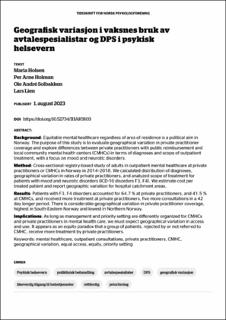Geografisk variasjon i vaksnes bruk av avtalespesialistar og DPS i psykisk helsevern
Peer reviewed, Journal article
Published version
Permanent lenke
https://hdl.handle.net/11250/3087749Utgivelsesdato
2023-08-01Metadata
Vis full innførselSamlinger
Originalversjon
10.52734/IHAK9103Sammendrag
Background: Equitable mental healthcare regardless of area of residence is a political aim in Norway. The purpose of this study is to evaluate geographical variation in private practitioner coverage and explore differences between private practitioners with public reimbursement and local community mental health centers (CMHCs) in terms of diagnoses and scope of outpatient treatment, with a focus on mood and neurotic disorders.
Method: Cross-sectional registry-based study of adults in outpatient mental healthcare at private practitioners or CMHCs in Norway in 2014–2018. We calculated distribution of diagnoses, geographical variation in rates of private practitioners, and analyzed scope of treatment for patients with mood and neurotic disorders (ICD-10 disorders F3, F4). We estimate cost per treated patient and report geographic variation for hospital catchment areas.
Results: Patients with F3, F4 disorders accounted for 64.7 % at private practitioners, and 41.5 % at CMHCs, and received more treatment at private practitioners, five more consultations in a 42 day longer period. There is considerable geographical variation in private practitioner coverage, highest in South-Eastern Norway and lowest in Northern Norway.
Implications: As long as management and priority setting are differently organized for CMHCs and private practitioners in mental health care, we must expect geographical variation in access and use. It appears as an equity paradox that a group of patients, rejected by or not referred to CMHC, receive more treatment by private practitioners

